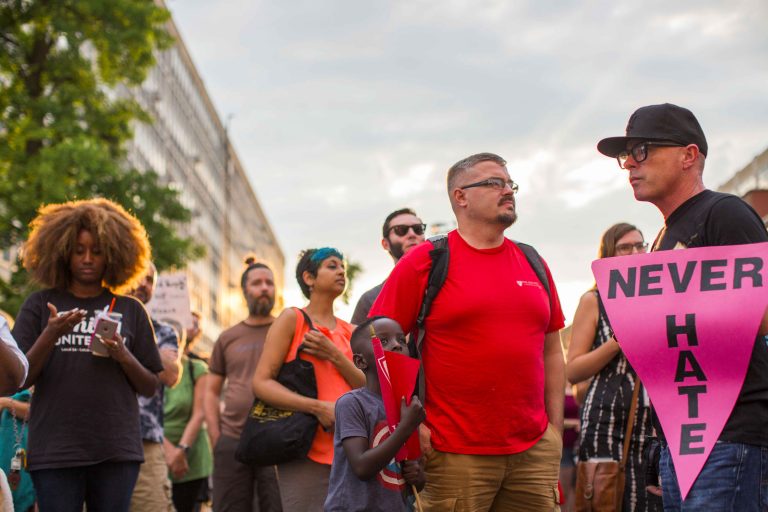
Demonstrators participate in a march and rally against white supremacy August 16, 2017 in downtown Philadelphia, Pennsylvania. Image by Jessica Kourkounis/Getty Images, © All Rights Reserved.
A New Narrative of Whiteness Is Unfolding
The headlines over the last few weeks have been filled with the worst of whiteness — Nazi knock-offs parading around with Tiki torches and a 20-year-old plowing a car into a multi-racial counter-protest; a police officer caught on tape reassuring a white citizen she doesn’t have to worry because “we only kill black people”; xenophobia bubbling up all over the internet and elsewhere thanks to the president’s announced intention to repeal DACA and send 800,000 young Americans to countries many of them have never even lived in.
But there is a different story starting to take shape. It doesn’t have a coherent narrative just yet. It doesn’t have a title like “white supremacy.” But if you look hard, it’s there. It’s nascent, but it’s critical to the future of this country.
It’s Heather Heyer, the 32-year-old woman killed in Charlottesville defending her belief in racial equality and her mother, Susan Bro, who has refused to become a White House photo op. At her daughter’s funeral she said,
“They tried to kill my child to shut her up. Well, guess what? You just magnified her.”
It’s Pearce Tefft, the father of avowed white nationalist Peter Tefft, who wrote and published a letter denouncing his son and his belief system in no uncertain terms:
“He once joked, ‘The thing about us fascists is, it’s not that we don’t believe in freedom of speech. You can say whatever you want. We’ll just throw you in an oven.’
Peter, you will have to shovel our bodies into the oven, too. Please son, renounce the hate, accept and love all.”
It’s the thousands of Virginians, the majority of them white, who filled the UVA campus in a vigil after all the violence, creating a sea of little united flames, singing and pledging to stand up, unafraid, to their violent, hateful brothers and sisters.
It’s the CEOs and artists, many of them white, who resigned from Trump’s various councils and committees after his refusal to take a bold stand against white supremacy.
It’s the organizing happening all over the country by Showing Up for Racial Justice and other groups formed specifically to help white Americans understand how to be proactive about fighting racism.
Maybe it’s you — attending a vigil in your own hometown, expressing genuine rage or grief on social media, reaching out to relatives that you think may harbor some of the same dehumanizing ideas as those who gathered in Charlottesville or those calling for deportation of young people (95 percent of whom are working or in school) and engaging them in overdue dialogue.
For so long, whiteness has either been invisible — almost like the neutral setting, as Miguel Clark Mallet wrote so eloquently — or it has been irredeemable, something to be ashamed of, something to disavow, something to try to escape through the parroting of black culture or tireless work to be one of the “good white people.” Both mindsets are ultimately unfruitful for real racial progress. One is a comfortable delusion — that whiteness is the norm and always will be. The other is a delusional comfort — that there is some way to earn transcendence from the moral abomination that is American whiteness, historic and contemporary.
But could it be that a third way is being born? Could it be that a narrative of whiteness that feels redeemable, principled, loud, unafraid, intentionally uncomfortable, even joyful, is starting to take shape? Has the white supremacy movement’s palpable surfacing finally allowed for a critical mass of white anti-racist Americans to step forward and declare the dismantling of white supremacy a personal priority?
Only time will tell. But for now we have some serious wrestling to do with our own consciousness and some serious changes to make — behaviorally and systemically. The truth is, even at a moment this galvanizing, the project of reimagining whiteness feels overwhelming. Where does one start? Attending a vigil is a powerful way to signal one’s commitment, a source of collective emotional catharsis, and, potentially, a way to build solidarity with other people who are poised to fight racism. But what does the fight itself look like? Where does it show up? Who are its leaders?
These are genuine, not rhetorical, questions. I don’t know the answers. I do know that we face many paradoxes:
- While now is undoubtedly the time to condemn white supremacy in no uncertain terms, we must also resist the temptation to split the world into good and bad white people. This false dichotomy suggests that the only problem is the bad white people (i.e. the white supremacists), when in fact, the problem is far wider and more deeply rooted than that.
- We must take full responsibility for our own emotional and logistical work in dismantling white supremacy, while maintaining constant humility. Not only are most of us nascent anti-racist activists, still learning the ropes of what kinds of personal work or organizing strategies are effective, but we can only do this work with integrity if we are in real relationship with people of color.
- We must fully acknowledge our own self-interest in fighting racism; we will be liberated by reimagining whiteness, as will our children and our children’s children. But as with so many long-term transformations, it won’t necessarily feel like liberation in the short term. It might feel like losing — losing opportunities, money, advantages, friends, time.
What we have to gain is nothing less than our own integrity, the healing of a moral wound that is at the center of white existence, even when the festering is invisible or called by other names.

